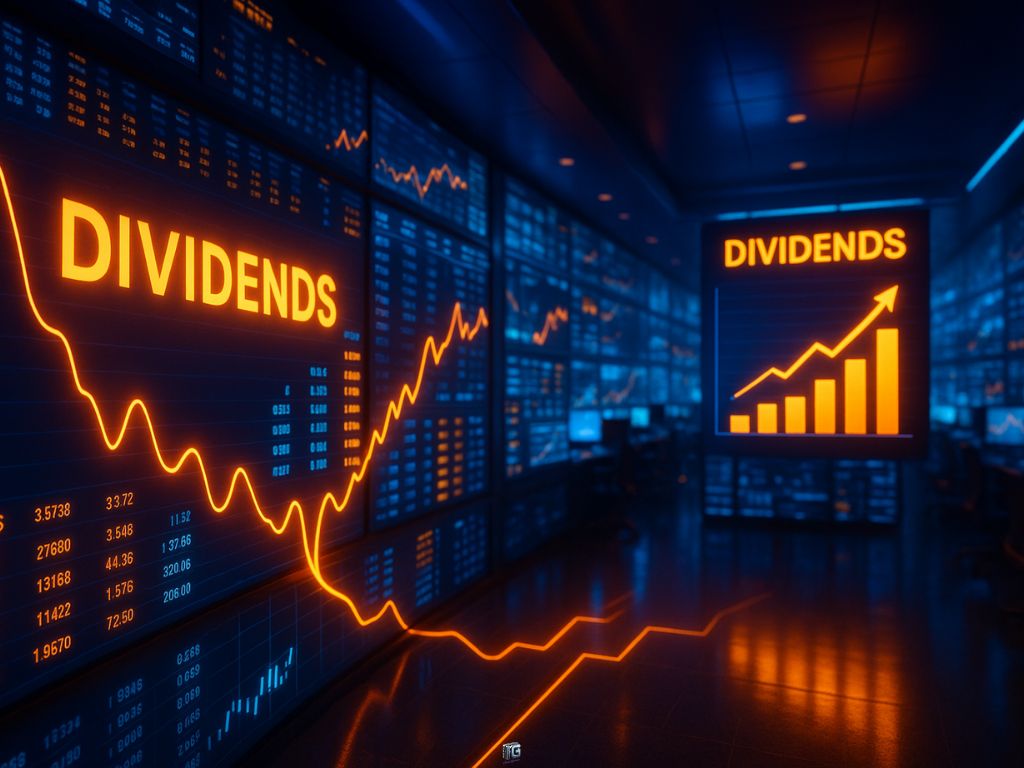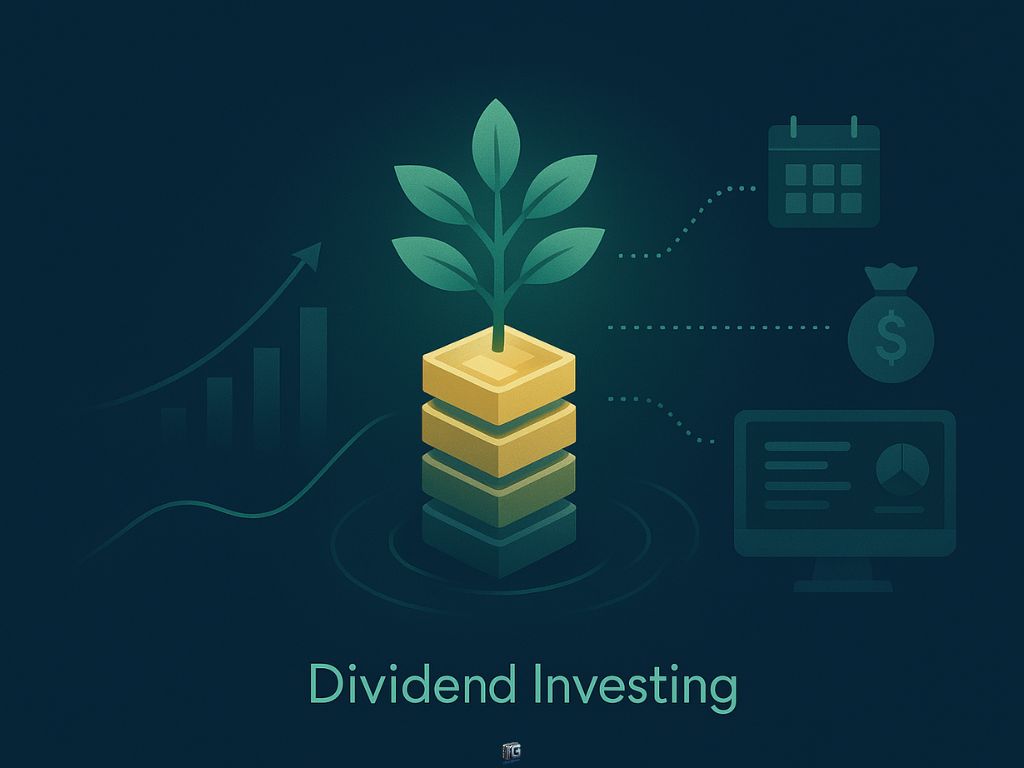Everyone online is chasing fast money. Flipping. Trading. Hustling. But most overlook a method that’s been paying quietly, reliably, and passively for decades.
It’s not exciting at first glance. It doesn’t go viral. But it works. It pays. And the best part? You don’t have to sell, trade, or even lift a finger once it’s set up.
It’s called dividend investing and while most people ignore it, those who understand it are getting paid month after month.
In this guide, I’ll show you exactly how dividend investing works, why it’s still one of the most underrated online income strategies, and how you can start even with a small budget.
No hype. Just real money, paid automatically.
Disclaimer: I am an independent Affiliate. The opinions expressed here are my own and are not official statements. If you follow a link and make a purchase, I may earn a commission.

What Is Dividend Investing?
Dividend investing is one of the simplest ways to turn your money into a source of consistent, recurring income.
Here’s how it works:
When you buy shares of certain companies, especially well-established ones, they actually pay you a portion of their profits. These payouts are called dividends.
You don’t have to sell anything. You don’t have to trade. If you own the stock, and that company issues dividends, you get paid. Automatically.
Some pay quarterly. Some pay monthly. But the model stays the same: you invest once, and the income keeps coming.
This isn’t new.
It’s how thousands of investors earn passive income without ever touching their portfolio just by holding the right stocks.
And if you’re thinking you need thousands to get started? You don’t. You can begin with as little as $50–$100, and start collecting dividends from day one.

How Dividend Investing Makes You Money
There are two ways dividend investing puts money in your pocket:
1. Regular Payouts (Cash You Can Use)
Let’s say you buy shares of a company that pays a $0.50 dividend per share every quarter. If you own 100 shares, that’s $50 every quarter just for holding the stock.
Multiply that by several companies, and the payouts add up.
Some investors get paid monthly, others quarterly, but either way, the money hits your account on a schedule like a paycheck you didn’t work for.
And yes, you can withdraw it and spend it.
2. Reinvesting (Compounding Your Income)
Instead of taking the cash, you can also reinvest your dividends to buy more shares. That means your next payout is based on a bigger position which leads to even bigger dividends.
This is how investors build wealth quietly over time: They let their dividends buy more dividends.
It’s the same snowball effect behind compound interest except this time, your income grows without you adding more money.
How to Start Dividend Investing (Even with $50–$100)
Getting started with dividend investing is surprisingly easy. You don’t need a broker. You don’t need a ton of cash.
And you don’t need to know everything just enough to make a smart first move.
Here’s how to do it:
1. Choose a Dividend-Friendly Investing App
Look for platforms that:
- Let you buy fractional shares (great for small budgets)
- Clearly show dividend yields
- Don’t charge commissions
Some beginner-friendly options include:
Each of these lets you start with $5–$100 and access well-known dividend stocks instantly.
2. Fund Your Account
Even a small deposit can get the ball rolling. With fractional shares, you can buy into dividend-paying companies like Coca-Cola, AT&T, or Johnson & Johnson without needing thousands.
Start with what you can afford but make the deposit. That’s when the system starts working.
3. Buy Stocks That Pay Dividends
Inside the app, look for:
- Stocks with a consistent dividend payout history
- A reasonable dividend yield (typically between 2%–6%)
- Large, stable companies or ETFs with strong reputations
You’re not looking for “hot” stocks. You’re building an income stream.
4. Turn on Automatic Reinvestment (Optional)
Most apps let you automatically reinvest your dividends. This means your earnings instantly buy you more shares without you doing a thing.
More shares = more dividends. And the cycle keeps building.
For more Proven Ways to Make Extra Money Online Go Here.

Best Dividend Stocks for Beginners
If you’re new to dividend investing, your first goal isn’t to pick the “perfect stock”, it’s to start with companies that are stable, consistent, and known for rewarding shareholders.
Here’s what to look for when choosing dividend stocks:
A Track Record of Payouts
Stick with companies that have been paying dividends for years ideally decades.
These are often referred to as “dividend aristocrats” or blue-chip stocks. They’ve weathered economic cycles and still paid investors on time.
Examples:
- Coca-Cola (KO)
- Johnson & Johnson (JNJ)
- Procter & Gamble (PG)
- PepsiCo (PEP)
Reasonable Dividend Yields
High yields can be tempting, but they’re not always safe.
A good range for beginners is 2%–6%. It’s steady enough to generate real income without taking on excessive risk.
Watch out for unusually high yields, those companies may be unstable or about to cut their dividend.
Dividend-Focused ETFs
Want instant diversification?
You can invest in ETFs (Exchange-Traded Funds) that hold dozens of dividend-paying stocks.
Top options include:
- VYM – Vanguard High Dividend Yield ETF
- SCHD – Schwab U.S. Dividend Equity ETF
- HDV – iShares Core High Dividend ETF
These funds spread your money across multiple companies, reducing your risk and increasing your stability perfect for getting started.

Passive Income or Long-Term Wealth? Why Dividend Investing Delivers Both
Most online income strategies force you to choose: Make a little cash now, or invest long-term and wait years to see results.
Dividend investing doesn’t make you choose. It quietly does both, at the same time.
Earn While You Hold
When you buy a stock that pays dividends, you don’t just hope it goes up in value. You actually get paid while you wait. Those dividends can be withdrawn and used like cash.
They’re deposited into your account automatically whether the stock price rises or not.
If your goal is to build a steady stream of income that doesn’t depend on sales, clients, or hustle, this is one of the cleanest models you’ll find.
Build Real Wealth Without Adding More Work
The secret power behind dividend investing is in reinvestment.
Every payout you receive can be used to buy more shares. And those new shares? They also pay dividends.
It’s a feedback loop one that builds momentum whether you touch it or not. Over time, your income increases on its own. And the longer you hold, the more powerful it becomes.
That’s why smart investors treat dividends as both income and strategy. You’re not just earning. You’re compounding.

Realistic Expectations: How Much Can You Actually Earn?
Let’s cut through the hype.
Dividend investing can absolutely become a powerful stream of income but it doesn’t happen overnight. And it doesn’t make you rich from $50.
What it does give you is a predictable, growing return and a way to start building income without selling your time, trading stocks, or launching a side hustle.
So let’s get real:
What $100 Looks Like
Let’s say you invest $100 into a stock or ETF with a 4% dividend yield.
That’s $4 per year paid out quarterly or monthly, depending on the stock.
It won’t change your life. But that’s not the point.
It’s proof of concept: You invested. You got paid. The system works.
Now scale it.
What $1,000 or $10,000 Looks Like
At $1,000 invested with a 4% yield, you’re earning around $40 per year.
At $10,000? That’s $400 annually, and that doesn’t include potential growth or reinvestment.
If you consistently reinvest, your annual dividend income increases automatically—even if you never add another dollar.
What Makes the Difference?
- Dividend yield: Higher yield = higher payouts
- Company consistency: Reliable dividend history matters more than hype
- Reinvestment: Compound growth is the key multiplier
- Time: The longer you hold, the bigger it gets
Is this a get-rich-quick move? No.
But it is a get-paid-every-year, even-if-you-do-nothing move.
And that’s what makes it worth starting especially if you’re tired of chasing quick wins that never land.

Frequently Asked Questions About Dividend Investing
Do I need a lot of money to start dividend investing?
No. Thanks to fractional shares, you can start with as little as $5–$100. Many beginner-friendly apps let you invest small amounts in dividend-paying stocks and still earn a portion of the payout.
How often do dividends pay out?
Most dividend-paying companies issue payments either quarterly or monthly. It depends on the company or fund, but once you own the stock, payouts are automatic based on their schedule.
Is dividend investing risky?
All investing carries some risk but dividend investing is generally considered more stable, especially when you focus on established companies with long dividend histories. Stick to businesses with consistent payouts, and avoid chasing unusually high yields.
Can I lose money with dividend stocks?
Yes, stock prices can go down. But unlike growth stocks, dividend stocks still pay you even if the price drops, as long as the company maintains its dividend. The key is choosing companies with strong financials and a history of stable payouts.
What’s a good dividend yield to look for?
For beginners, a dividend yield between 2% and 6% is usually a sweet spot. Higher yields might seem tempting, but they can signal risk. Look for consistency over hype.
Where can I buy dividend stocks?
You can start with trusted platforms like:
- M1 Finance (great for automated portfolios)
- SoFi Invest (user-friendly and clean interface)
- Webull or Robinhood (for direct stock picking with no commissions)
These apps let you start small, invest in dividend-paying stocks, and automate reinvestment if you choose.
Can I withdraw my dividends as cash?
Yes. Most platforms give you the option to withdraw your dividend payouts as cash or reinvest them into more shares. You’re in control.

Final Thoughts: Why Dividend Investing Still Wins
Most people overlook dividend investing because it isn’t loud. It doesn’t promise overnight success or viral headlines.
It just works quietly, consistently, and over time. You don’t need to trade, you don’t need to learn charts, flip products, or sell anything.
You simply own the right assets… and get paid to hold them. That’s what makes this different from every other money method online.
It’s not a hustle, it’s not a gamble. It’s a system anyone can use no matter how much they start with.
You can:
- Start with $50–$100
- Get your first dividend within weeks
- Reinvest it or withdraw it
- And watch it grow quarter after quarter
Dividend investing isn’t just passive income. It’s long-term leverage. And the earlier you begin, the more powerful it becomes.
You’ve read enough. Start with one stock. Fund the account. Let your money go to work.
The passive income everyone else misses is right in front of you.
Next: Check out our How to Earn Using Investing Platforms Guide.
1 Comment
21 Proven Ways to Make Extra Money Online in 2025 - Ismel Guerrero. · July 14, 2025 at 8:10 pm
[…] out our Dividend Investing Guide […]